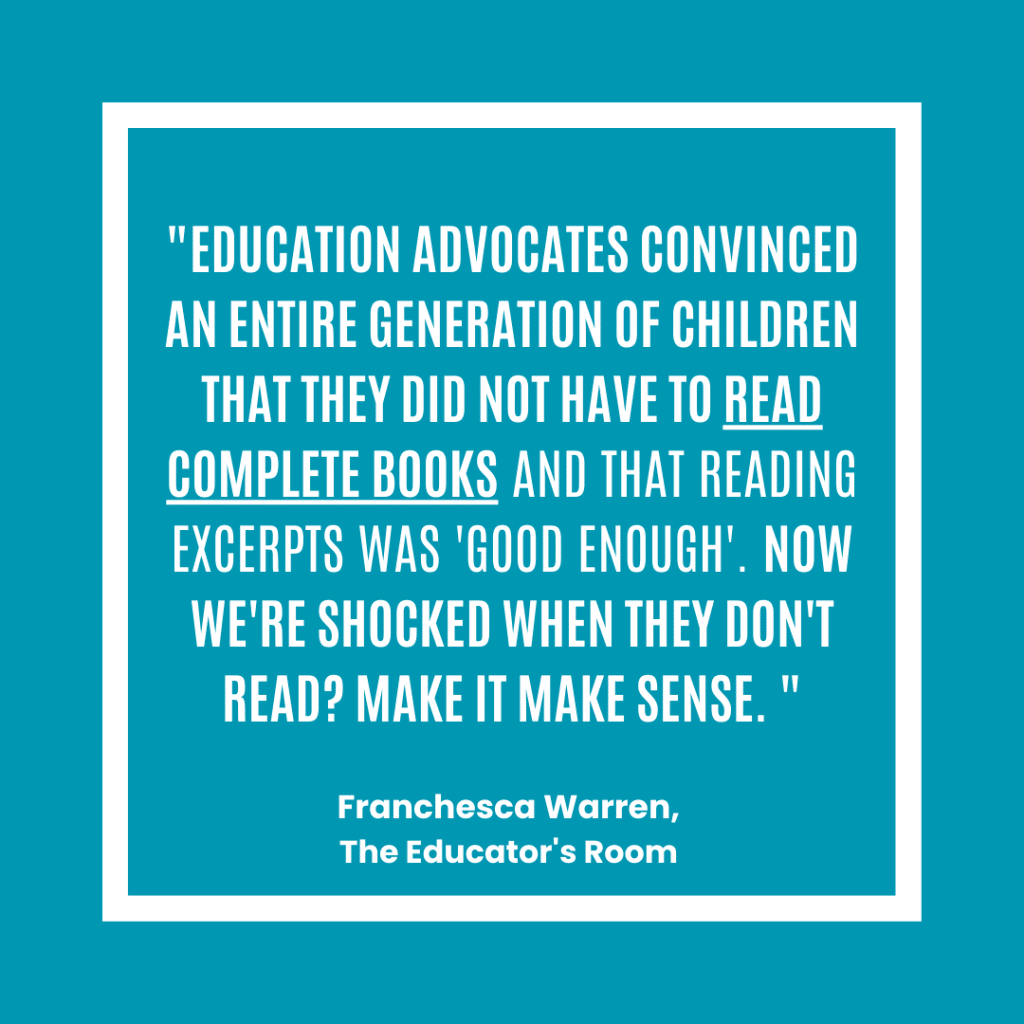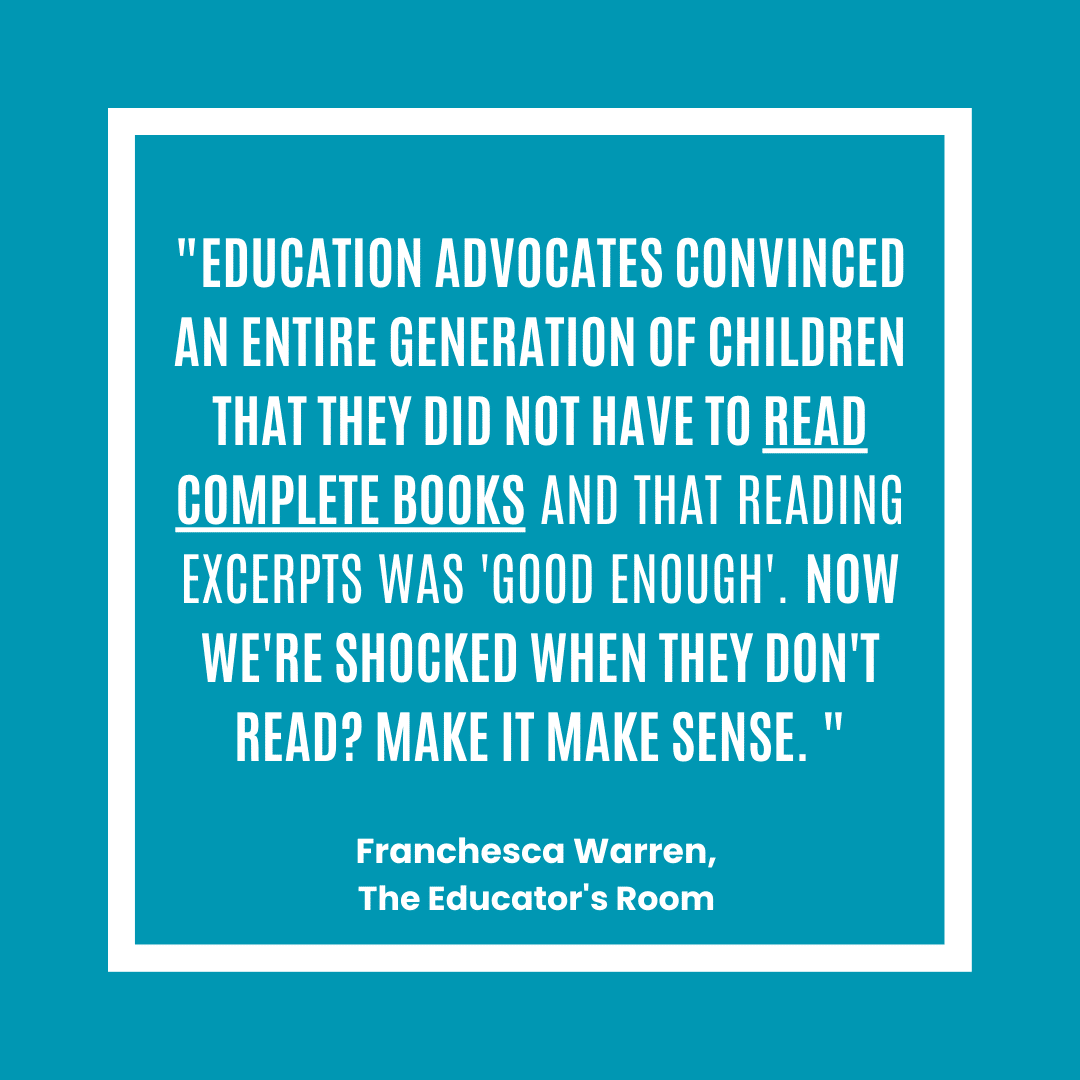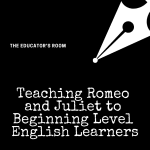Overview:
In order to change outcomes for students, we must change the conditions on how they are taught to read.
This morning I opened my laptop, and in my inbox, there were two article titles on reading levels that immediately gave me anxiety.
- Why Minnesotan kids lag in their reading level, and what can be done to help
- Half of elementary students not reading at grade level
- I immediately shut my laptop and went on a run, but as I was exercising, I realized that kids don’t value reading because we don’t value it as a society.
Hear me out.
What Teaching Secondary English/Language Arts Used to Be Like
As a former High School English teacher, my goal was to make my students think critically about the world around them. I used the reading, writing, speaking, and listening standards to help them a) understand the world they lived in and b) how to advocate for what they need as students of the world. We explored the works of James Baldwin, Zora Neale Hurston, Alice Walker, and other contemporaries while studying the place African Americans play in the fabric of the United States.
We’d spend hours talking about the characters and life and helping students formulate their ideas into coherent writing. Even my kids who struggled wanted to join in discussions about the book(s), and they would at least try. There was a struggle for kids who hated to read, but there was a shared understanding that if I made learning relevant, they would try to engage.
However, in my last decade in the classroom, I noticed that the way kids digested information had drastically changed, and to be quite honest, it’s our fault that the change was so bad.
How We Destroyed the Love of Reading
First, education advocates convinced an entire generation of children that they did not have to read complete books. Instead, they thought exposing them to excerpts of texts was an appropriate substitution. Teachers (and kids) were told that excerpts were more important than books. Now we’re surprised that kids don’t read. In the words of my students, let’s make it make sense.
After getting everyone on board of abandoning reading entire books, scripted curriculum/ lesson plans were introduced in English/Language Arts/Reading where “education advocates” demanded all teachers teach the same thing, the same way- no matter what. Teachers were written up, resources were confiscated, and principals were threatened with losing their jobs if there was a deviation from what was supposed to be taught.
There was a shift in state standards that boasted more rigorous standards and used the ways we measure reading (i.e., Lexile) and upped all the reading levels 1-2 grade levels in hopes that this shift would help kids become better readers. Suddenly kids who had been on “grade level” were behind, which caused stakeholders in the school to repeat the failed cycle above.
Then came the technology advocates who replaced paper books with tablets and computers for kids to read digitally. In some schools, books were sold, thrown away, or stashed in the basement as we focused on the “next phase” in reading. Millions of dollars were spent to make sure all kids had the latest technology at their fingertips.
From there, we saw entire schools that totally abandoned the idea of kids’ reading to focus on teaching test-taking skills and introducing excerpts just to convince kids that if they were not annotating them, they were not “active reading.” In these schools, teachers were told to stop teaching at least one month before state testing just to focus on “drill and kill” of the state standards. In hopes of making kids read, we mandated reading logs and took books out of the hands of kids because they were not on their reading levels.
But with all these changes, did anything change? Did kids become better readers? Are we in a renaissance where kids enjoy reading?
No, I would argue that in 2023 the love of reading is gone for most students. They would much rather scroll their phones than pick up the latest thriller from their local libraries.
The Impasse in Reading Education
Unfortunately, we’re now at an impasse in education, and children’s reading abilities may be at their lowest.
If you don’t believe me, look at the headlines about American students and their reading levels/abilities:
- “America’s reading problem: Scores were dropping even before the pandemic” “It’s ‘Alarming’: Children Are Severely Behind in Reading”
- “More Than 1 in 3 Children Who Started School in the Pandemic Need ‘Intensive’ Reading Help”
The actual data is even more sobering.
- Some 34% of students are below basic reading level in the fourth grade, according to the U.S. National Center for Education Statistics (NCES). Another 31% are below the proficient reading level.
- About 27% of eighth-grade students are below basic reading level, per NCES. Another 39% are below the proficient reading level.
This data tells us that what we have done has not/will not work and that to help kids become readers, we need to change the conditions that allow kids (and society as a whole) to become readers.
But what should we focus on?
Of course, we need a renewed way of teaching how to read and support from legislators to fund and mandate that we use evidence-based strategies to help all our kids; however, we have an additional need that many are forgetting.
We have to put focus on not only putting books in front of kids but also stopping the endless scrolling that’s making our kids zombies in their learning.
I have witnessed students who can scroll for 90 minutes straight; yet complain when asked to read a chapter in a book that will take them (at most) 30 minutes. Students have become mesmerized with the online persona of their favorite artists and can detail every bit of their lives but struggle to go outside and engage with friends. I have witnessed the attention spans of kids are nonexistent, yet they check their phones every 1-2 minutes. And with all that I have observed, students’ reading levels have remained low with us in the same cycle of blaming kids and teachers when the conditions are not there.
To make kids more robust, more confident readers, we need to create the conditions they need to read.
Think about it in terms of teaching yourself how to change the tires on your car. You can be like me and have ZERO experience, or you may already be an expert and need something completely different. In addition to the conditions (i.e., flat surface, space to change the tire, etc.) I need the right tools (carjack, tire, etc.) to succeed, along with the proper support (i.e., feedback, etc.) to help me with any issues.
Culture Shifts Needed to Change Reading Habits
In changing the culture around reading, we must focus on creating conditions that make reading an integral part of what we do inside the classroom and at home. When we do that with intention, students’ reading levels will increase.
The first culture shift would focus on pausing the dependency on technology for kids in 3-8 grades and instead focus on building their content knowledge box through reading. At this age in development, we must make schools safe zones where technology is strongly controlled- including cell phones- and kids spend time learning content. If kids need to learn a concept in science, before we ask a child to search Google, we should spend time helping them read/understand the content, use notes to reinforce the content, and use science labs to reinforce the concepts. It’s only then that technology should be introduced as a reinforcement. This isn’t just reserved for behavior at school.
Parents need to set boundaries at home where kids don’t pick up the iPad as soon as they get home but instead get some time outside and spend time reading to reinforce what they have learned at school.
The next culture shift would focus on time in school (and at home) to read. This should not be a one-time deal or something to do to punish kids or done haphazardly to meet a requirement. Kids need time to read in an environment conducive to learning. Teachers need reading time to conference with students and help pull small groups.
Kids should see their parents reading, and parents should carve out uninterrupted time to read. This can be magazines, comic books, graphic novels, or even manuals, but focusing on what your child already enjoys can help them overcome the “I hate to read” phase many of our kids go through. The truth is, you can only become a strong reader by reading.
The last culture shift will be to rethink how we offer support to students to continue to help them become better readers.
Currently, support to help students reach their reading level can feel punitive to parents, teachers, and students. Every year, the same kids get told they are not on level; the same year, it feels like punishment to get them on track.
Parents are blamed, students are blamed, and teachers are blamed for “low” reading scores.
- But what if we reframed our unconscious bias about students who struggle to reach “grade level”?
- Instead of pointing out what they struggle with, how about we drill down on skills and make that the focus on K-2 education?
- What if we made literacy hubs where kids had books readily available instead of iPads and phones?
- What if every public library had a mobile book that went into communities and read to students?
- What if we did away with grades in elementary school and focused strictly on skills?
- What if support for kids sat next to them in class and helped them address the small misconceptions before they became bigger?
- What if districts had access to free literacy training regardless of their federal funding or whether they were rural, suburban, or urban school districts?
- What if college training programs were mandated to teach reading based on evidence, not programs?
Rethinking Our Approach
We must rethink this approach. Reading is about growth and exercising your brain muscle. So if we dig deep into the individualized support needed for every child, we can begin to move kids. This “we” isn’t just the teacher. It’s also on the parents who know their children to help fill in the gap and use available resources (i.e., tutoring, community-based organizations, etc.). Rethink support as a prescription to get better. No shame, only support.
Rethinking the conditions for students to read is the first step in reversing a generation of bad habits around reading.






